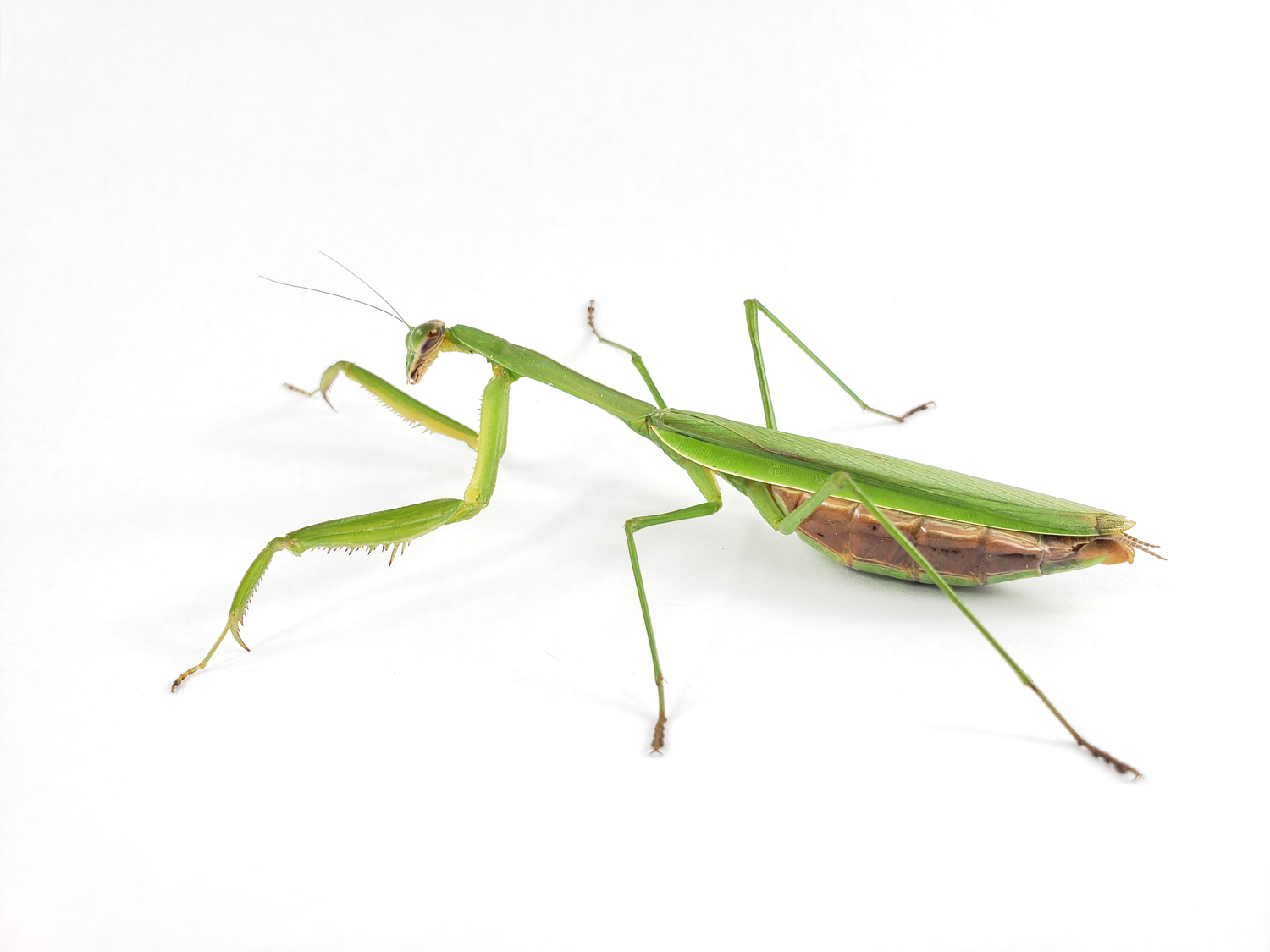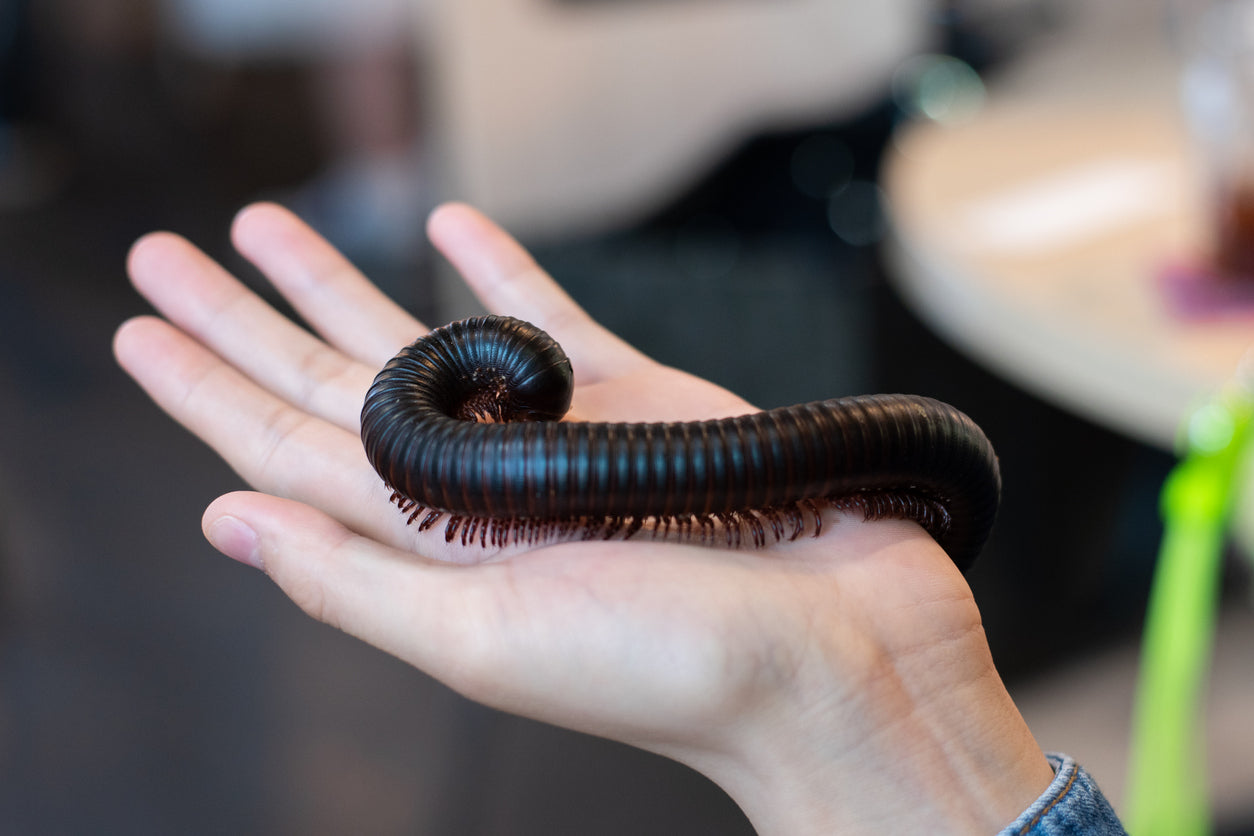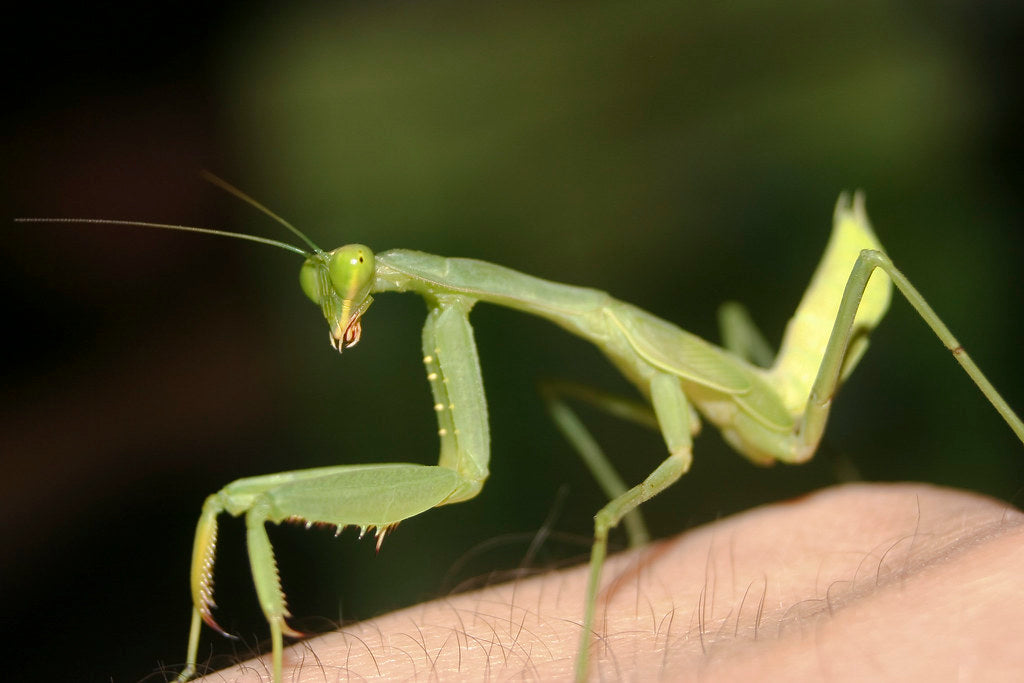The Chinese mantis (Tenodera sinensis) is a medium-large, diurnal, carnivorous invertebrate native to east and southeast Asia. However, this species has been introduced to the United States, and because of their popularity as a form of pest control, Chinese mantises can be found in most parts of the US, particularly in the East.
Chinese mantises have a fairly typical praying mantis appearance with a long, sticklike body, large eyes, a triangular head, long thin antennae, a slender abdomen, long thin legs, and serrated forelimbs. Their wings are functional. They are fairly large for praying mantises, and average around 4” long. Coloring is brown to green, with brown individuals having their forewings lined with green.
Chinese mantises are very popular as pets, and the adults are fairly easy to care for, although the nymphs can be difficult to keep alive. For this reason it’s best to buy a pet Chinese mantis as an adult or subadult. Total lifespan is 8-12 months, depending on sex.
How much space do Chinese mantises need?
The general rule with housing praying mantises is that the enclosure length and width should be at least twice that of the mantis, and the height should be at least three times the mantis’ length. 32oz deli cups with fabric vented lids often work well for juveniles. Adults and subadults should be housed in a Kritter Keeper, terrarium, or mesh box measuring at least 8”L x 8”W x 12”H, such as the Exo Terra Mini Wide Terrarium.
Chinese mantises are highly cannibalistic, so they should NEVER be housed together!
Do Chinese mantises need special lighting?
As long as the mantis’ enclosure is in a room that receives ~12 hours/day of artificial or bright natural light, then additional lighting equipment is unlikely to be necessary. However, if it is being kept in a dark room, then the terrarium will need its own lighting equipment.
What temperatures do Chinese mantises need?
Chinese mantises usually do well between 70-80°F, so they can be kept at room temperature. Avoid temperatures above 88°F and below 50°F. Keep track of the temperatures inside your enclosure with a digital thermometer like the Zoo Med Digital Thermometer & Humidity Gauge, with the probe placed in the middle.
It’s best practice to provide a temperature gradient within the enclosure so they can self-regulate their body temperature according to their needs and preference. To prevent potential overheating, avoid using heat sources with mantis nymphs. However, it should be safe to use a heat lamp in a full-size mantis enclosure.
To provide a “basking spot” for your Chinese mantis, use a Zoo Med Nano Dome Lamp Fixture with a low-wattage heat bulb like the 25w Zoo Med Nano Basking Spot or similar. Place this on the extreme left or right of the enclosure. Do not place the lamp on top of the mesh, as this can burn your mantis. Instead, suspend the lamp from a Zoo Med Reptile Lamp Stand or similar. The heat lamp should be turned off every night.
Note that heat lamps should not be used with Kritter Keepers or other plastic-top enclosures.
What humidity levels do Chinese mantises need?
Humidity is very important for successfully keeping praying mantises as pets, as it helps ensure successful molting and general wellbeing. The Chinese mantis requires average humidity levels of 50-65% to stay healthy.
To increase and maintain healthy humidity levels, lightly mist your mantis’ enclosure with a spray bottle at least 1x/day. If you are using a mesh rather than glass/plastic enclosure, then you will likely need to spray more heavily and more often.
Humidity levels should be monitored with a Zoo Med Digital Thermometer & Humidity Gauge or similar with the probe placed in the middle of the enclosure.
What substrate is good for Chinese mantises?
Substrate is important to a Chinese mantis enclosure because it helps maintain healthy humidity levels. Many mantis keepers prefer to use a bioactive soil substrate with springtails, isopods, beneficial bacteria and fungi, and live plants because it makes it easier to keep the enclosure clean. However, bioactive can be complicated to get right if you’re new to it, so here are some other substrate options:
- Zoo Med Creatures Eco Soil
- Zoo Med Creature Soil
- Zoo Med ReptiBark
- Eco Earth Plantation Soil
- Exo Terra Forest Bark
- Zilla Bark Blend
You don’t need very much substrate. Depending on the size of the enclosure, 1-2” should be plenty. However, you will need more for the plants’ roots if you plan to create a bioactive setup.
To keep your Chinese mantis’ enclosure clean, replace the substrate weekly and completely rinse out the enclosure and decor with hot water. Don’t use soap or disinfectants, as the residue may harm your pet!
What décor can you use in a Chinese mantis terrarium?
Chinese mantises like having things to climb and hide behind in their enclosure. This encourages natural behaviors, which makes them more fun to watch, and decreases stress, which in turn increases lifespan. Here are some ideas:
- twigs
- thin vines
- live plants
- artificial foliage
Climbing objects should be arranged at a variety of angles to give your mantis options. Not having to hang upside-down all the time also helps prevent potential disfigurement. Hot glue is excellent for adhering climbing objects and artificial foliage to terrarium walls.
Make sure to leave an open space at the top of the enclosure twice the height of your mantis for molting.
What do Chinese mantises eat?
Praying mantises are carnivorous, which means that they eat other insects and sometimes even small animals. Avoid overfeeding, as this will shorten your pet’s lifespan. Food should be offered every other day, as much as your mantis will take — they stop eating when they’re full. The best way to keep track of how much your mantis is eating is by offering food via tweezers held directly in front of the mantis.
As a general rule, feeders should be live and no larger than 1/3 of the mantis’ length. Options include:
- Flightless fruit flies
- Rice flour beetles
- Bean beetles
- Black soldier flies and larvae
- Blue/green bottle flies
- Dubias
- Discoids
- Silkworms
- Hornworms
- Mealworms
- Superworms
- Katydids
- Grasshoppers
- Wax moths
Flying prey is particularly favored, but avoid offering bees or wasps. Due to parasite/disease concerns, it’s generally considered best practice to avoid using crickets as feeders for praying mantises.
All feeders should be generously hydrated and gutloaded for at least 24 hours prior to offering to your mantis. This makes sure that your pet gets the best nutrition possible from its meal. Good foods for feeder insects include:
Another way to make sure your mantis gets balanced nutrition is to offer a wide variety of different types of feeder insects.
Do Chinese mantises like to be handled?
Generally speaking, it’s best practice not to handle pet invertebrates very much, if at all. While there are exceptions, Chinese mantises often have calm dispositions, and are less likely to strike or bite at a human. To pick up your mantis, do not grab it. Instead, offer your hand in front of the mantis and encourage it to step onto your hand. Handling should be rare — invertebrates are best considered “look but don’t touch” pets.
Do not handle or otherwise disturb your mantis within 3 days or so after a molt, as the exoskeleton is particularly soft after molting, making them vulnerable to injury. Prior to molting, it is normal for mantises to refuse food. Molting occurs every 2-3 weeks for juveniles and every 3-4 weeks as they near adulthood.
*This care sheet contains only very basic information. Although it’s a good introduction, please do further research with high-quality sources to obtain additional information on caring for this species.
"File:Chinese mantis (Tenodera sinensis) side.png" by SwimSusan is licensed under CC BY-SA 4.0




Leave a comment
This site is protected by hCaptcha and the hCaptcha Privacy Policy and Terms of Service apply.